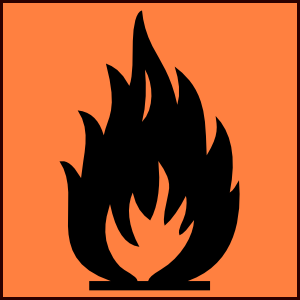Chemistry ... Safety Symbols...
By Sulekha Rani.R , PGT Chemistry, KV NTPC Kayamkulam



Corrosive
Will destroy or irreversibly damage another substance with which it comes in contact. The main hazards include damage to eyes, skin and tissue under the skin, but inhalation or ingestion are also very risky. Avoid contact, and bear in mind that these can (under some ciurcumstances) rust chemical cupboards.
Flammable Symbol

Flammable or extremely flammable
Chemicals to be stored in flame-resistant cupboards. Volatile solvents can be a particular problem as they are prone to spread around from unsealed containers. This also covers pyrophoric materials (that catch fire spontaneously on exposure to air).
Chemicals to be stored in flame-resistant cupboards. Volatile solvents can be a particular problem as they are prone to spread around from unsealed containers. This also covers pyrophoric materials (that catch fire spontaneously on exposure to air).
POISONOUS
![[poisonous.gif]](https://blogger.googleusercontent.com/img/b/R29vZ2xl/AVvXsEh1SnDWXBjsEc0xjPfmdQ-IiLV3vvajqE1Vae2nO5XvxzNjmjm-gtesON72YGLqfq7-dSMUEznK0d7FmiYDRYwnjhyCfcJAMpJeaCTlbW6FcS9VDfW_WjXU84bLtj54gpRrMXPe34KydYw/s1600/poisonous.gif)
Poisonous
The poison symbol is self-explanatory. Whereas most chemicals are fairly dangerous if ingested or inhaled, many of these are dangerous even on contact.
![[oxidising.gif]](https://blogger.googleusercontent.com/img/b/R29vZ2xl/AVvXsEi-wxvK1WgsFvay12axAmOEWcycB5Tr17Yx_QwtskyA_rHWfQDE39IX6JSEH6yHsQMoH2ebo-OH9WzRSJ8bfP0JRnXC_9ZLP3ZM5rLNtnguGDThlSUr5IVCPJWO3idtvekW_dIz5ZPecBc/s1600/oxidising.gif)
Oxidising chemical
Oxidising chemicals are materials that spontaneously evolve oxygen at room temperature or with slight heating, or that promote combustion. To be kept away from flammable chemicals at all costs!Explosive

Explosive
Again, fairly self-explanatory, though fairly seldom seen in the average lab. Bear in mind that noise and movement can also trigger explosion (not just sparks/flames!).
Again, fairly self-explanatory, though fairly seldom seen in the average lab. Bear in mind that noise and movement can also trigger explosion (not just sparks/flames!).

Relatively rare with laboratory chemicals (most of which pose some environmental hazard if not got rid of correctly), these require particular care to be taken on disposal.
radiation warning

BIO HAZARD

ionizing radiation warning symbol

Radio waves hazard symbol
Non-Ionising radiation

CHEMICAL WEAPON
